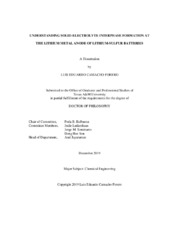| dc.description.abstract | Lithium-sulfur (Li-S) batteries are one of the most promising chemistries for the next generation of energy storage devices. In a standard Li-S cell, the metallic lithium anode is an essential component of the battery due to its low density, extremely high theoretical specific capacity, and very low negative electrochemical potential. However, several challenges related to the use of Li metal have prevented this battery technology from becoming commercially available. For instance, Li-anodes are highly reactive, which results in the continuous decomposition of the electrolyte and the formation of the solid-electrolyte interphase (SEI) layer. This, combined with the non-uniform deposition of Liions during plating at the anode surface, can seriously affect the performance, cycling, and safety of the battery. In addition, it has been suggested that a controlled SEI formation at the metallic Li anode can yield enhanced battery performance. Hence, a comprehensive understanding of how the SEI layer is formed can help elucidate improvements in this battery technology. In this work, the formation of the SEI layer in Li-S batteries is investigated using density functional theory (DFT) and ab initio molecular dynamics (AIMD) simulations. The stability of liquid organic-based electrolyte components, salt concentration, electron-rich environments, and the use of inorganic solid-state electrolyte (SSE) materials are explored in order to provide molecular-level fundamental insights into how the nature and composition of the electrolyte can alter the initial stages of the SEI formation.
The products of electrolyte decomposition and electro-/chemical reaction pathways of liquid electrolyte component such as solvent and salts are predicted from AIMD simulations of electrolyte-anode interfaces. Energetics of reactions from DFT ground-state optimizations are also presented to confirm the decomposition mechanisms. Some significant differences are then drawn regarding the use of low and high salt concentrations. Simulations under electron-rich environments show additional multielectron electrochemical reactions of solvent and salt decomposition taking place due to the excess of electrons and the presence of radical anions in the solution. Finally, the initial stages of formation, stability, and main constituents of interfaces between Li-metal and Sbased electrodes with sulfide-based SSEs are characterized in detail. | en |


